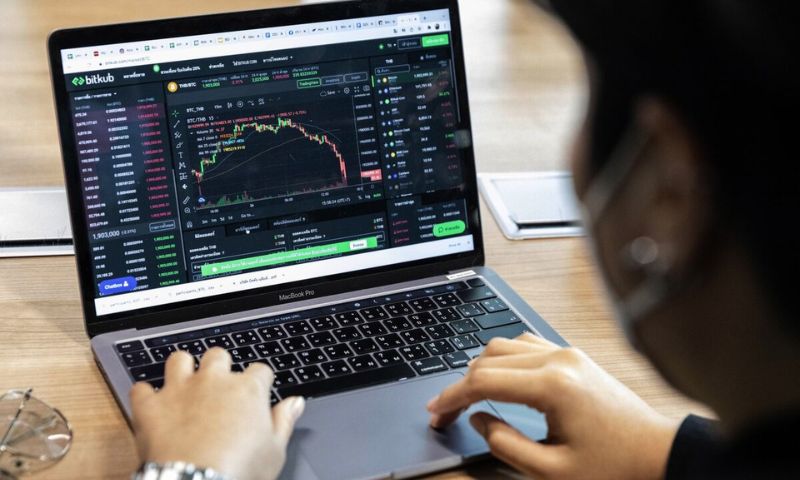On-chain analysis for cryptocurrencies is not just a buzzword—it’s your key to smarter investing. Peel back the layers of market noise, and you’ll find a treasure trove of data whispering the secrets of the crypto world. I’ll guide you through the essentials, showing you how to monitor wallets and track transactions, so you can spot the quiet moves that could predict the next big price swing. Dive into network health and the right tools to unearth the tales told by Bitcoin and Ethereum. Stick with me, and you’ll learn to read market trends like a pro, seeing through whale moves and sniffing out shifts in liquidity. And for those who are ready, we’ll push into the advanced zone, decrypting smart contract signals and DeFi’s on-chain dance. Let’s unlock the vault of investment secrets together!
Understanding the Basics of On-Chain Analysis
Exploring Wallet Address Monitoring and Transaction Tracking
On-chain analysis is like a crypto detective’s toolkit. It digs into blockchain data. This helps us to track how coins move from one wallet to another. We keep tabs on wallet addresses. This means we know where coins start and end up.
Crypto transactions leave public trails. By keeping track of them, we can tell a lot about who’s buying or selling and when. Blockchain activity analysis takes this further. It looks at all the action on the blockchain. This gives us clues about the market’s health.
Tools for Bitcoin block explorer techniques come in handy here. Think of them like search engines for Bitcoin. They let us look into every detail of Bitcoin transactions. Ethereum data parsing is similar for Ether tokens.
Grasping Token Movement Investigation and Blockchain Activity Analysis
Understanding how tokens move is key. It’s about spotting patterns in the data. Big movements can shake up the market. These are often made by “whales” – folks with lots of coins.
Token movement investigation checks where these big coins go. It’s important because it can predict big price changes. It follows the money trail on the blockchain.
Blockchain activity analysis is broader. It checks how the blockchain works day-to-day. This includes everything from how many transactions happen to how busy it gets. This can point to rising or falling interest in a crypto coin.
By poking into this data, we learn tons about the crypto world. We spot trends. We see danger signs like pump and dump schemes. We can also see money moving across different crypto exchanges.
Investigating this stuff helps people make smarter choices with their money. It’s not easy, but it’s worth it. Knowledge is power, especially in a world as fast-paced as crypto.
The Role of Network Health and Data Parsing Tools in Crypto Analysis
Utilizing Bitcoin and Ethereum Exploration Techniques
Imagine you have a crypto map. This map shows how digital money moves and grows. Bitcoin block explorers and Ethereum data parsing are like tools to read this map. They help us see every transaction and wallet’s journey on Bitcoin and Ethereum.
These tools let us dig into every corner of Bitcoin and Ethereum networks. We watch wallets closely. We follow token paths. We notice when big amounts of crypto are on the move, which we call large-scale movements. By doing this, we figure out what’s happening with our investments and make smarter choices.
Assessing Crypto Network Health Indicators and Miner Transfer Patterns
Now, how do we know if a cryptocurrency is doing well? We look at crypto network health indicators. Think of them like signs that tell us if a crypto is sick or strong.
We also track miners’ transfers. Miners are like workers who keep crypto moving and safe. They also send crypto around. How and where they send it can teach us a lot. It can show us how much they trust the network and if they think it’s worth more or less.
We study the flow of crypto assets, like a river. We want to understand where the money starts and where it ends. This helps us see the big picture of how crypto is doing worldwide.
In the end, by keeping a close eye on these things, we can guess better what will happen next. We can’t see the future, but we can be very good detectives with these tools. Plus, we can avoid traps like pump and dump schemes, where some try to trick us into bad deals.
All this helps us keep our money safe and make good choices. When we invest in crypto, we need to know as much as we can. That’s what being smart with our money is all about.
Identifying Market Trends through On-Chain Metrics
Examining Liquidity Pools and Exchange Volume Dynamics
To get ahead in crypto, look at liquidity pools. These pools hold money for trading pairs. They show how easy it is to buy or sell big amounts. We can track the money flowing in and out. This shows us if a token is getting popular or not. By watching this, you know when to make your move.
Liquidity tells us how much trust we can put in price changes. Big volume means more meaningful price moves. This insight helps us make smarter choices. In simple terms, exchanges work like big markets, and we can watch the traffic. Are more folks buying or selling? This tells us where things might go next.
Detecting Whale Transactions and Interpreting Large-Scale Crypto Movements
Watching whales matters a lot in crypto. Whales are folks who own a lot of crypto, like Bitcoin or Ethereum. When they make moves, it makes waves. We track huge transactions to guess what they might do next.
Whales can shift markets alone. They can also make trends trickier to see. By tracking their actions, you can better time your own moves. Think of this like a game of follow the leader. We want to spot these giants’ moves early. It’s like being a detective in a huge city of money.
We can see the health of Bitcoin and Ethereum by how much it costs to make transactions. This cost shows us how busy the network is. When gas fees rise, the network has lots of traffic. This can tell us about possible price swings.
By following the big players, you might catch trends before they make headlines. It’s all about understanding the signs and signals on the blockchain. By keeping a sharp eye on exchanges, we can make better decisions.
Remember, timing can be everything. Use these on-chain clues to help you jump in or out at the right moment. Always stay curious and keep learning. The blockchain is always talking. Make sure you are listening.
Advanced On-Chain Analysis Techniques for Crypto Investment
Analyzing Smart Contract Interactions and DeFi On-Chain Activities
Smart contracts do a lot for cryptocurrencies. They’re like robots that carry out orders without fail. When you want to invest right, you need to look at how these contracts work. This helps you figure out what’s good in the DeFi world. DeFi stands for “decentralized finance”—it’s the new way to handle money, all done on the blockchain.
Looking at smart contracts, ask, “Are they doing their job?” Check how often they run and how much it costs each time. This gives us clues. One clue might be that lots of money is moving through one. This could mean people trust it a lot—or maybe not, and that’s important.
We also watch DeFi. It’s hot in the crypto space. Here we see new ways to lend, trade, and earn. We look for big action like a rush of money moving in or out. This can tell us if something big is starting or maybe winding down.
When we talk DeFi, we’re saying, look at where the money lives. See if it stays, or if it runs away when things get rough. This watchfulness helps us make smart bets with our cash.
Now to smart contracts—we ask, “Who’s using them and how fast?” Good answers come from solid data. We see lots of use as a thumbs up. It means people are jumping in and getting busy. But, lots of use could mean costs to use them go up. Higher costs can slow things down.
Remember, in crypto, knowing who’s playing the game can pay off. So we keep tabs on wallet addresses in the DeFi scene. Changes there can send big signals. And those signals point to where the money might go next.
Deciphering On-Chain Sentiment Indicators and Gas Fee Trends
Now, let’s dig into feelings in the crypto world—yep, even numbers have moods. That’s what we call sentiment. It’s like a weather forecast for the market. With on-chain data, we look for happy signs or signs that folks are nervous.
Gas fees are like a mood ring for Ethereum—they show how busy or calm the network is. High fees mean it’s party time: lots of deals and folks making moves. Low fees can suggest a quiet time. Maybe it’s good for some buying.
Knowing this stuff tells us what folks might do next with their coins. We peek at how much gas they spend and tie it back to sentiment. More spending can mean things are about to pop, less can give the opposite hint.
In short, strong analysis means keeping a close eye on all this. It’s how you avoid traps and find golden chances. It’s detective work and it pays to stay alert.
In crypto, just like in life, the signs are all there. You just need to know where and how to look. And that’s what I do—I keep watch and read the tales told by the data. That’s how you find what’s coming before it comes knocking.
I’ve shared loads about on-chain analysis in this post. We looked at how you can track wallet addresses and follow the money across different token movements. Plus, we talked about how healthy a crypto network is and how to use tools to dig into Bitcoin and Ethereum. I also showed you ways to find market trends by checking out liquidity pools and watching what the big money players do.
Don’t just take my word for it, dive in and use these methods yourself. By checking out smart contracts and DeFi stuff, and keeping an eye on fees, you can really get ahead. With these tools, you can make smarter choices and maybe even get a leg up in the crypto world. Remember to always stay sharp and keep learning. Every piece of info helps us make better investment decisions. Let’s keep our crypto journey smart and strong!
Q&A :
What is on-chain analysis in the context of cryptocurrencies?
On-chain analysis refers to the examination of publicly available transaction records and other blockchain-related data of cryptocurrencies. By analyzing these data points, investors and analysts can gain insights into the economic activity and trends within a cryptocurrency market, such as Bitcoin or Ethereum. It includes tracking transaction volumes, wallet addresses, the movement of coins, and network hashrate among others.
How can on-chain analysis be utilized to make investment decisions?
On-chain analysis can be a powerful tool for making informed investment decisions. By monitoring indicators such as the number of active addresses, transaction value, and the flow of coins between exchanges and personal wallets, investors can gauge market sentiment and potential price movements. This information can help in assessing the health and maturity of a crypto asset, allowing for better predictions of bullish or bearish trends.
What are the key metrics to look at in on-chain analysis?
Key metrics in on-chain analysis include the total value locked (TVL), which shows the amount of crypto assets currently staked in a blockchain protocol; transaction count and volume, which reflect the network’s activity and liquidity; and the number of new and active addresses, which can indicate growth in the user base. Other important metrics are the hash rate, mining difficulty, and the distribution of coins across wallet addresses.
Can on-chain analysis predict cryptocurrency price movements?
While on-chain analysis cannot predict prices with absolute certainty, it provides a data-driven approach to understand the underlying dynamics of the crypto market. By analyzing trends in the on-chain data, such as increased accumulation of coins by large holders (often called “whales”), one may infer potential price movements. However, it is crucial to combine on-chain analysis with other forms of analysis and market news to make more comprehensive predictions.
What distinguishes on-chain analysis from traditional market analysis?
On-chain analysis is unique because it deals with transparent and immutable transaction data that is inherent to blockchain technology. Unlike traditional markets, where some data might be private or not readily available, the blockchain provides a complete transaction ledger that is accessible to anyone. This leads to a more open form of analysis that relies on quantitative data directly from the network, as opposed to traditional markets that might require more qualitative or speculative methods.






